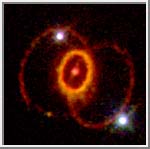|
COMETS EARTH JUPITER KUIPER BELT MARS MERCURY METEORITES NEPTUNE OORT CLOUD PLUTO SATURN SOLAR SYSTEM SPACE SUN URANUS VENUS ORDER PRINTS
PHOTO CATEGORIES SCIENCEVIEWS AMERICAN INDIAN AMPHIBIANS BIRDS BUGS FINE ART FOSSILS THE ISLANDS HISTORICAL PHOTOS MAMMALS OTHER PARKS PLANTS RELIGIOUS REPTILES SCIENCEVIEWS PRINTS
|
Related Document
Download Options
This striking NASA Hubble Space Telescope picture shows three rings of glowing gas encircling the site of supernova 1987A, a star which exploded in February 1987. Though all of the rings appear inclined to our view (so that they appear to intersect) they are probably in three different planes. The small bright ring lies in a plane containing the supernova, the two larger rings lie in front and behind it. The rings are a surprise because astronomers expected to see, instead, an hourglass shaped bubble of gas being blown into space by the supernova's progenitor star (based on previous HST observations, and images at lower resolution taken at ground-based observatories). One possibility is that the two rings might be "painted" on the invisible hourglass by a high-energy beam of radiation that is sweeping across the gas, like a searchlight sweeping across clouds. The source of the radiation might be a previously unknown stellar remnant that is a binary companion to the star that exploded in 1987. The supernova is 169,000 light years away, and lies in the dwarf galaxy called the Large Magellanic Cloud, which can be seen from the southern hemisphere. The image was taken in visible light (hyrdrogen-alpha emission), with the Wide Field Planetary Camera 2, in February 1994. Image use statement at the time this image was obtained. All of the HST images available via WWW and ftp may be used without restriction as long as credit information accompanies the picture. Credit usually includes the principal scientist responsible for the data, AURA/STScI, NASA and/or ESA, the European Space Agency. Specific credit information may be found in the captions accompanying the images as plain text files. The captions are available via links from the Web pages as well as separate files in the gif directory on the ftp server. |
